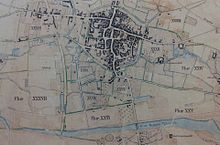Mühlenteich and Stadtbach (Düren)
Düren mill pond and Stadtbach were and are inner-city watercourses in the district town of Düren , North Rhine-Westphalia . They are only part of the mill ponds in the old district of Düren .
The city of Düren is a gift from the mill pond, a small artificial tributary of the Rur , the watercourse that emerges from the Rur today above the Lendersdorfer bridge. Without this mill pond , Düren would not have developed into a city. The Düren mill pond not only drove the old mills, it also flowed as a city stream through almost all streets of the city and not only provided brewers , tanners , cloth makers , households, etc. with the necessary water, but was also a municipal water supply and disposal channel from back then. There were public wells for drinking water.
Supply of the city stream with water through the mill pond
In today's Friedrichstrasse , which was still called Bachstrasse until May 7, 1889, an open stream derived from the mill pond flowed at Courtenbachshof in upper Oberstrasse , where there was also a weir , and flowed as the highest at the corner of Bonnerstrasse and Hohenzollernstrasse Point of the city in the moat outside the city walls .
Now the water of the Rur has reached the tributary “Mühlenteich” and the weir at Courtenbachshof in Oberstraße via Bachstraße (now Friedrichstraße) to Bonner Straße / corner of Hohenzollernstraße, and then flows into the city moat - but how did the water get inside the city to fill the city stream with vital water?
At that time, the water from the mill pond flowed through the moat to the east as well as the western side of the city wall to the lowest point on Philippstrasse (height difference and natural gradient at that time approx. 5 meters) - the water supply point for the city stream was today's Stürtzstrasse (Düren) / corner of Altenteich . Today's upper Altenteich did not have a passage to Stürtzstrasse in the Middle Ages or later because it was blocked by the city wall and various old houses. Only a "Kalle" dialect for pipe , under the old city wall, allowed the water to flow through to feed the city stream. That is why the upper part of the Altenteich up to the Steinweg was also called "Op de Kallen" and was mentioned as such in 1441.
The old city stream of Düren was not only a lifeline and water supplier for businesses and private households, but also as a sewage and disposal channel.
In the Middle Ages it must have really stank to heaven in Düren, because the many households and businesses poured everything into the city stream, from commercial waste to human droppings and leftover meat from butchers and tanners.
Daily cleaning of the city stream
Once a day, mostly in the evening, the weir locks at Courtenbachshof were opened and the Stadtbach was flooded with water in order to dispose of all rubbish via Schießbach on Philippstrasse.
After previous restoration, the old town stream was covered with iron plates in 1894/95 and later channeled.
Individual evidence
- ^ Rolf Terkatz: Lifelines of the city - the Dürener mill ponds, Super Sonntag v. December 1, 2019, p. 3
- ↑ Various history sheets of the Düren history association

